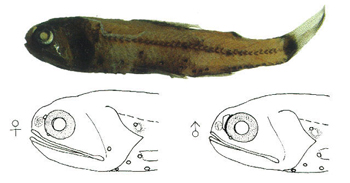EAF-Nansen Science Meeting on mesopelagic fish
On November 6 to 9, 17 experts from Africa, the Bay of Bengal, Norway and FAO met to discuss various aspects of the ecology and the abundance of mesopelagic fish. This is a group of fishes living at depths of between two hundred and one thousand metres (called the twilight zone) throughout the world oceans. Because of their widespread distribution and the presence of high concentrations locally, they have been regarded as possible targets for industrial fisheries since the 70ies, although to date no major fishery has developed.
 Diaphus dumerilii © FishBase |
Recent acoustic studies suggest substantial mesopelagic biomasses (10 billion tons or more) are to be found in the world’s subtropical and tropical oceans, an order of magnitude higher than the previous global estimate. Interest in mesopelagic fish has also been revived by the ever-increasing need for fishmeal and marine oils by a growing aquaculture industry.
Because of the above, and as part of the EAF-Nansen Programme, dedicated surveys with the RV Dr. Fridtjof Nansen, were carried out in 2017 and in 2018 in the Atlantic and Indian Oceans to collect acoustic data, obtain biological samples, and carry out experimental work with the overall objective of developing survey methodology and increasing the knowledge on abundance and ecology of this poorly known community.
Based on the data and samples collected so far, as well as those coming from future surveys, the expert group discussed research projects related to methodological aspects of acoustic estimation of mesopelagic fish, to improve existing estimates of abundance, to the ecological role they fulfil, e.g. such as prey for top predators, or to other ecosystem services they provide (e.g. related to the carbon cycle). Aspects related to their biology such as growth, recruitment and mortality, essential for their sustainable utilization, were also covered.
Research activities will be carried out as a joint international effort, with PhD and master students guided by senior scientists both from partner countries and from Norway. Key results are expected already in 2020-2021.
